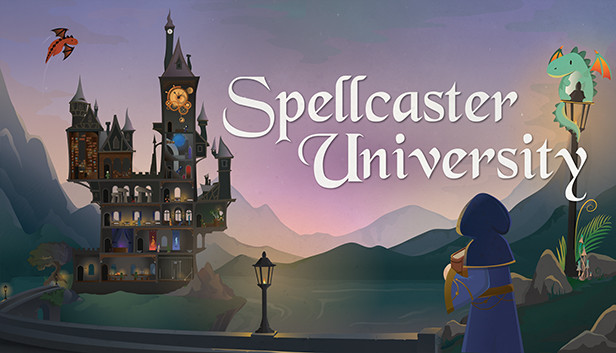Basic information about the game to help you start a new game strong and beat the Dark Lord!
Too Long! Gimmie the short, short version!
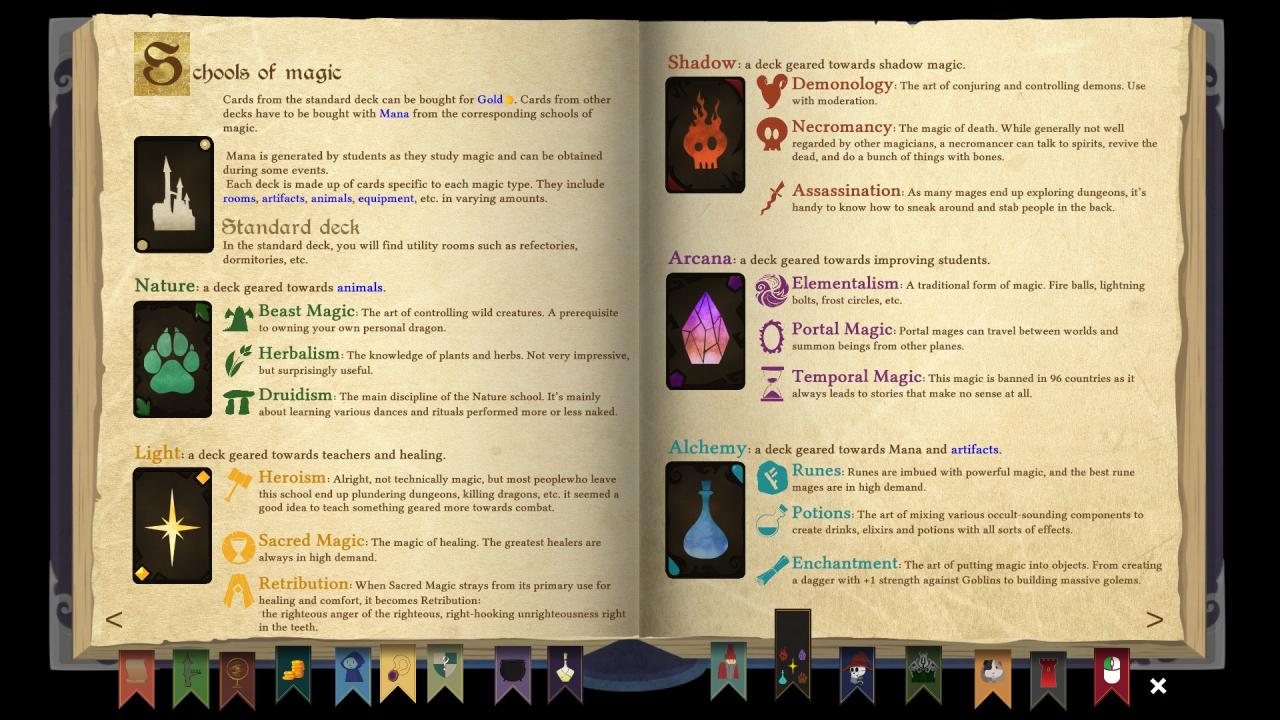 Get to the Help Book in game by clicking the gears in the lower left or hitting [esc] to read the tutorial information at any time.
Get to the Help Book in game by clicking the gears in the lower left or hitting [esc] to read the tutorial information at any time.
Oh, was that too short? Here’s how I start a campaign:
Pick the Lake location first and select either of the options that give you classrooms. Arcane/Alchemy is a great starter because of the permanent bonuses even lower-level futures can give in those schools, but Light/Shadow is heaps of fun too. For beginning of game choices: take nature mana from peasant faction so you don’t start the game with someone angry at you, then round out the last two classroom types using the starter money if possible. Take an advanced room instead of gold from the king, as that doesn’t count as a draw that increases the cost of the next card.
Pick star quests that are simpler for the first round: specialize in the magic type you have the most rooms for. For “train a certain number of this profession” quests, the ones with lower numbers are harder professions to get. Twenty Priests is easy, three dragon riders can be tricky, and if it is asking you to get just one forget about it for the first two schools unless you are playing the longest game on the easiest difficulty setting.
The lake quest is completed via the communications on the left hand side, but can be put on hold and accessed any time and failing it doesn’t affect your star rating. For stage one you need either three refectories or an aquarium pet (alchemy deck.) A level three refectory doesn’t count, it must be three rooms. In stage two collect four different dragons (the fairy dragon counts.)
Go to the king to ask him to beat back the forces of evil to stall for time, or get items to make the Dark Lord like you enough to hit 75 reputation to slow him down. The Portal/Demonology combo and graduating Deepfolk also slows him down, but he is inevitable.
Decks and Basic Mechanics
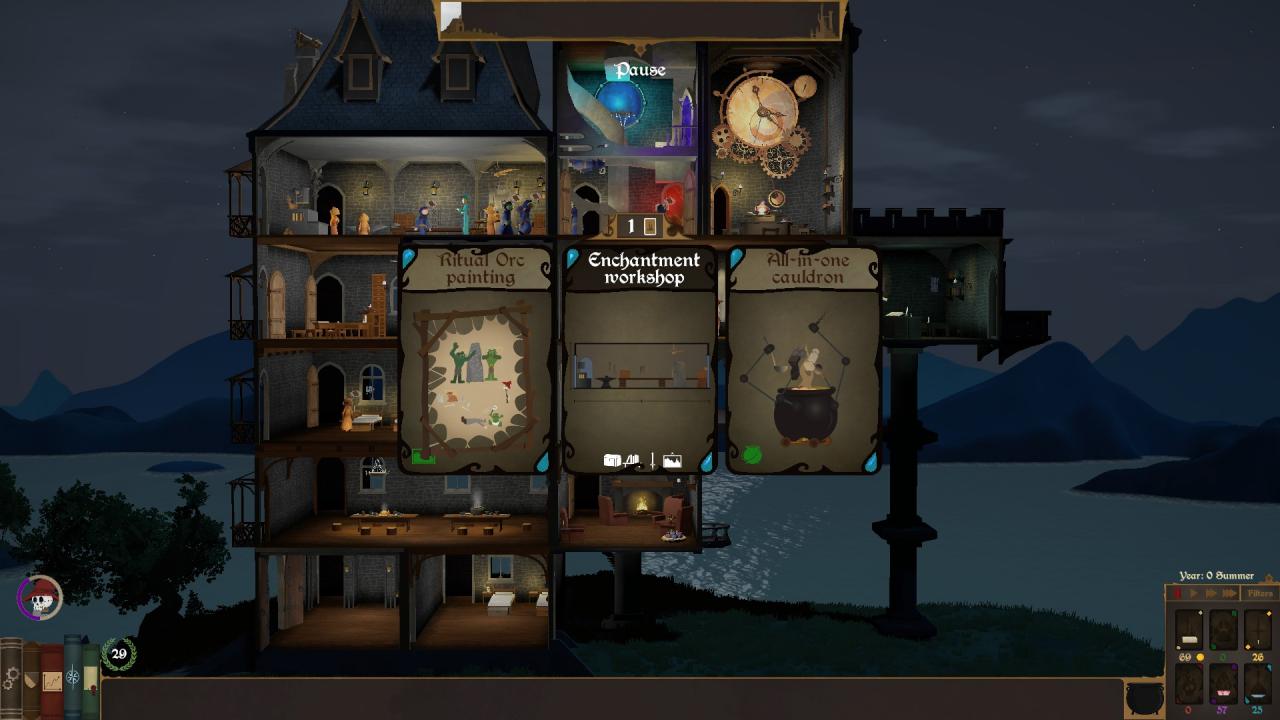 Each time you draw a card, the deck becomes more expensive. At the most basic level, the more cards you draw the more options you have so you want to start drawing cards from all decks as fast as possible. At the start you only have gold, which is used for the castle deck. This deck is used for general castle services such as dorms, but also for the general classrooms. Always take a general classroom if you don’t have it already so that you can start teaching that type of class and drawing from that specialized deck. Short term, this is your primary goal: make more mana.
Each time you draw a card, the deck becomes more expensive. At the most basic level, the more cards you draw the more options you have so you want to start drawing cards from all decks as fast as possible. At the start you only have gold, which is used for the castle deck. This deck is used for general castle services such as dorms, but also for the general classrooms. Always take a general classroom if you don’t have it already so that you can start teaching that type of class and drawing from that specialized deck. Short term, this is your primary goal: make more mana.
For example: the Shadow room is a general classroom teaching all three types of shadow magic (Necromancy, Demonology, and Assassination) at the same time. You get this card from the castle deck, allowing you to start earning Shadow Mana points. It teaches these subjects slower than a specialized room, but the special rooms are only drawn from the shadow deck using Shadow points.
Over time you will get a feel for the themes of the decks. There are a lot of decor items that give bonuses of all kinds and can even tech students while they sleep!
Rarely, you can draw student cards from several decks, giving you 5 new students as soon as it is played: Vampires from Shadow, Elves from Light, Half-Orcs from Alchemy, etc. You also get some new human students every season and can purchase/acquire student cards from different factions on the map if certain events are going on, such as non-human refugees at the merchant camp or vampires from the cemetery. There are even some items that will increase the chances that you will get non-humans in your regular applications. More students, more mana generation, more cards drawn!
What is Winning?
Think of it as you have students out in the world being awesome Archmages, teachers, Litches and so on, and you get kickbacks. Also, dead or crappy students just get you kicked. More prestige means more students to choose from, so students that hurt your prestige when they graduate are a problem. That goes double for Deepfolk, because high-prestige futures for them push the Dark Lord’s progress back.
For each round, you will acquire 3 “Star quests” over the first year of the game through communications pop-ups. There tends to be one to make a whole bunch of mana of one type, one to train certain skills and get a number of specific futures, and one that is story-based. The more stars you get, the better the spell book you collect at the end of the round. Each spell book takes up a place on the shelf in the headmaster’s office and conveys a permanent boost of some kind. There are quite a few. They can be a mild boost to incoming student’s intelligence, an efficiency boost to every room on the same floor as a Rune Scriptorium, or just a heap of money delivered once a year [ostensibly from using Time Magic to cheat at sports betting, which I find hilarious.] I think the best one is reduced cost increases for drawing cards from any deck. The sheer amount of savings that discount provides is staggering, and rolling that one early makes the whole campaign go much smoother.
You also must choose one of three cursed scrolls at the end of each round. As far as I can tell, being utter garbage and getting no stars does not make the curses any worse and playing like a master with three stars before the Dark Lord is even halfway to the school doesn’t make them any better. How well you play only seems to affect the spell books, with the cursed scrolls being completely random. You can pick curses that your existing buffs directly counter, or that your playstyle has no trouble with.
Some spells and curses drastically change the game and others are fairly invisible. Having all the students misbehave more often makes for a chaotic game where Drooler pets, Janitor rooms, and void potions are much more valuable. The bonus for floors with a Rune Scriptorium makes you spam Runes’ classrooms up and down your school, basically meaning you will always be focused on Runes/Alchemy to a certain extent, changing what quests will be easiest to complete.
The Headmaster’s Office
Using the Organic Meals option takes planning ahead: Stables(1 high 2 wide) and Greenhouses (1 high 2 wide, air above w/ no upper connection) next to the refectory increase efficiency, but the upkeep cost is doubled so it costs you gold instead of making it. (Find upkeep costs in the statistics book in the lower left of the main game window.) It can help on higher difficulty levels, but you have to build the school with that in mind and leave empty space around the refectories for the stables and greenhouses to be built later.
On the wall is a listing of all the potential futures your students have achieved. Each time a student graduates as something new, it will unlock the line here. It starts completely blank, but is useful for figuring out the conditions for challenges. Want to know how to train more Archmages [four level 4 skills]? Need to train twenty priests? If you trained one of any profession at any point in a campaign, you could check here to see how to make more. Unfortunately, you don’t unlock this information across campaigns, and need to discover it again each time. I’m hoping that gets changed in an update as it is quite annoying.
Rooms and Capacity
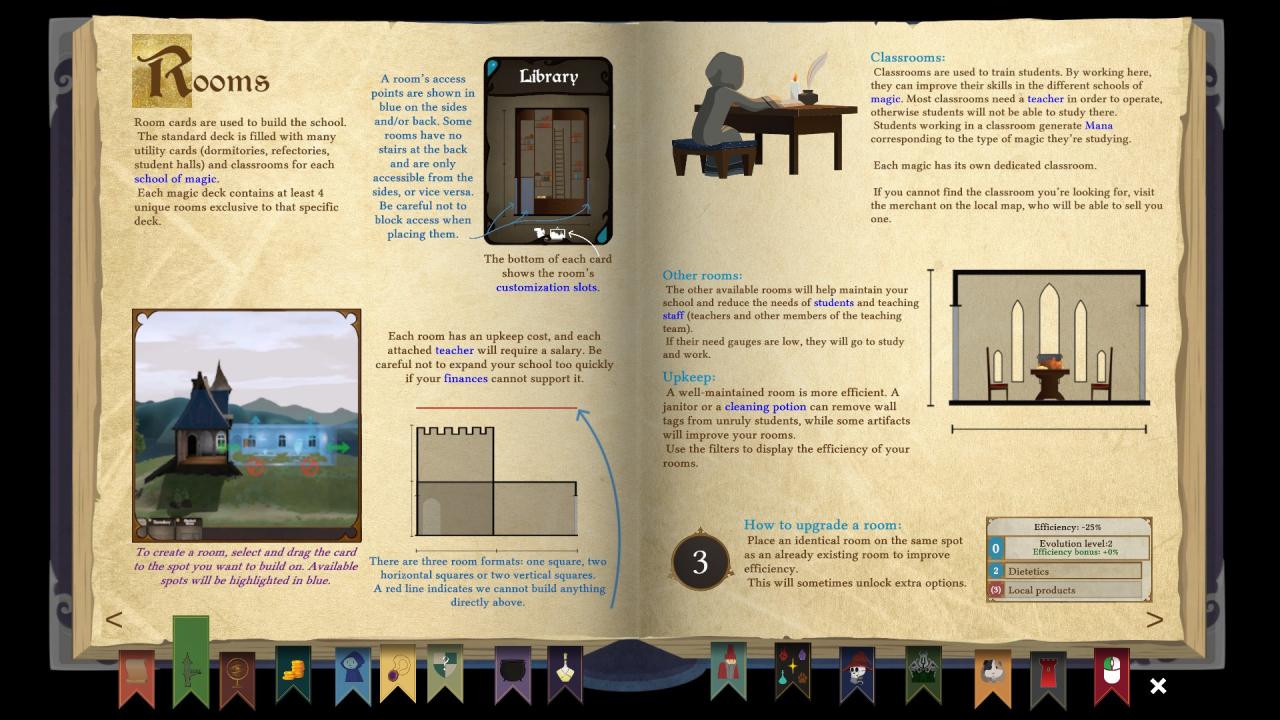 Rooms come in several sizes: One tile, two tiles vertical, two tiles horizontal, three tiles vertical, and four tiles square. No room has more than two tiles of ‘useable’ space. Rooms like the Observatory that have a red line above them look like they are two tiles high, but are technically an extra tile higher than they look (for a total of three tiles in that case) and do not connect to rooms above them. They can be built around by stacking rooms next to them, but the “unused” top tiles require a bit more planning or you can bloc yourself from building higher at all. The greenhouse is another ‘red-line’ room, but as the ‘used’ space is two blocks long it functionally takes up four squares. Each room card has markings showing how it connects to other rooms. Doors on the right and left are indicated with grey bars and the black door in the background is a stairwell to go up/down. Rooms without the door only connect side to side and rooms without the grey bars only connect up/down.
Rooms come in several sizes: One tile, two tiles vertical, two tiles horizontal, three tiles vertical, and four tiles square. No room has more than two tiles of ‘useable’ space. Rooms like the Observatory that have a red line above them look like they are two tiles high, but are technically an extra tile higher than they look (for a total of three tiles in that case) and do not connect to rooms above them. They can be built around by stacking rooms next to them, but the “unused” top tiles require a bit more planning or you can bloc yourself from building higher at all. The greenhouse is another ‘red-line’ room, but as the ‘used’ space is two blocks long it functionally takes up four squares. Each room card has markings showing how it connects to other rooms. Doors on the right and left are indicated with grey bars and the black door in the background is a stairwell to go up/down. Rooms without the door only connect side to side and rooms without the grey bars only connect up/down.
Most one-tile wide rooms hold three students and two-tile wide rooms hold five, even if they are multiple tiles tall. Exceptions include the refectory (10) and the psychologist (1.) You can usually count chairs/beds to see the capacity. If you get a second copy of a room card, you can play a room card on top of an existing room of the same type to level it up or place a second copy of the room elsewhere. Students use either copy of the room semi-randomly, preferring closer rooms. They only reserve a seat in class once the teacher starts teaching and that seat is held for them during their travel time to the seat, so organizing rooms together by type can help cut down the time taken up just getting to class. Keep in mind that students will also use dorms and refectories in the same way, so the dorm all the way to the left and the one all the way to the right will likely see different students based on what classrooms are nearby.
While it is nice to get all the rooms built as soon as they get into your hand so they can start making mana, occasionally quests will require you to have a room card in your hand to pick certain options. This guide is more for general information, so I won’t list them all out here, but generally speaking the chances of getting the event isn’t so great that you should be sitting on a handful of rooms unless you are well ahead of the game. Other cards are more commonly needed in hand for quests, like certain potions or décor items, and most quests with a room requirement need you to have built the room in your school.
The Gazebo is a unique shape. It is a one wide three tall room that only connects to one side on the middle. You place it using the bottom square, clicking one tile below where you want it to connect. Like all rooms, it can hover in the air using magical pillars, but it must connect from the side to the middle of the three tiles it takes up. Also, since it only connects to one side it is a dead end on seven of its eight faces, so look carefully at the card and expect to hold it in your hand for a while before placing it in just the right spot.
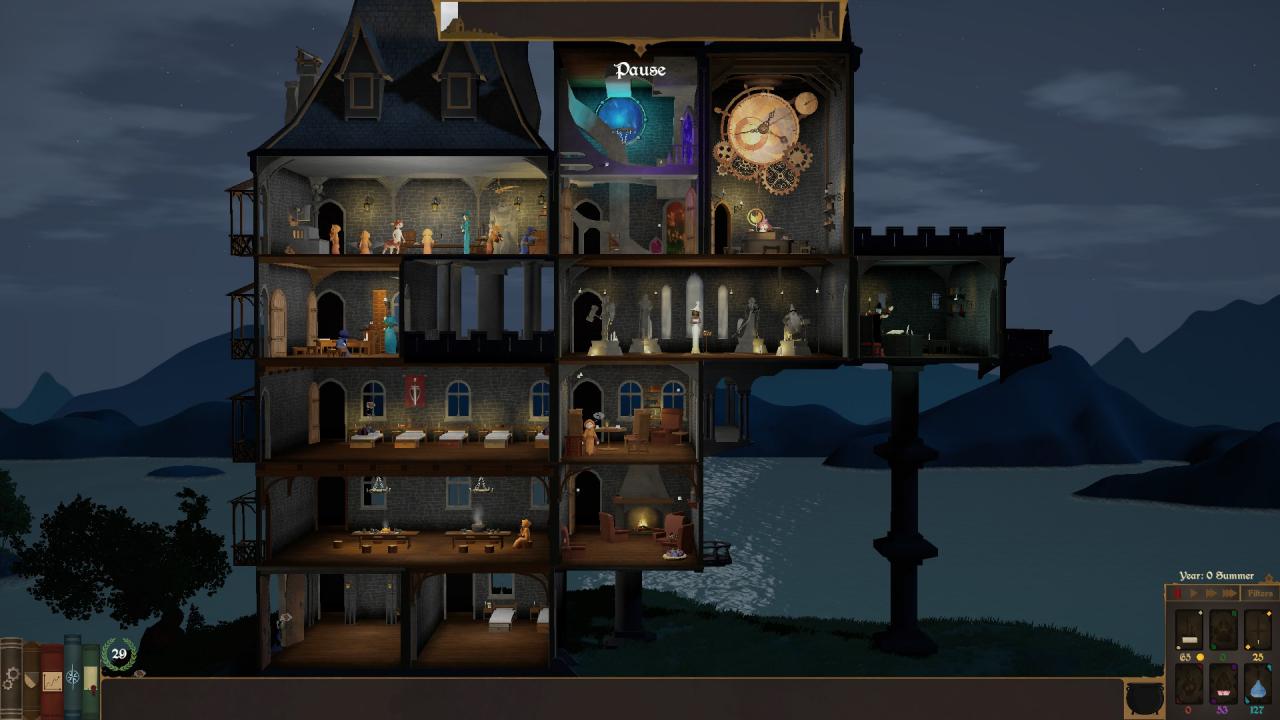 The Trophy Room: I like to leave a one-tile blank in the middle of four general education rooms at the start of the game for a Trophy Room (light mana deck) – a room that gives the bonuses for all the décor items inside it to the four adjacent rooms. Since all gen-ed rooms connect vertically and horizontally this is relatively easy to engineer. Ivy’s area of effect buff doesn’t stack with the Trophy room, it is still limited to adjacent rooms only, so putting that in the trophy room is a bit of a waste. You can also put one down next to the rooms associated with your quests, but having the bonuses for all the items in the trophy room going to four different gen-ed rooms means all or nearly all of the student population will touch those and it is something I can easily set-up before even knowing what the quests will be. I can always set-up a second one next to the quest rooms, especially since I’ll want two of each of those. Jamming it full of items that teach magic and wrapping it in dorms/refectories, libraries, a Portal room, or other rooms without a teacher is also a decent strategy as those rooms are never left idle while the teacher goes to tend their needs. Combining a stuffed Trophy Room with the Priesthood card (light mana) on an adjacent room, which removes a teacher’s needs for sleep and food, or the Mentor Card (alchemy mana,) which makes a teacher much better at teaching students, can boost up one of those Gen-ed rooms into a high-speed learning center rocketing students to the top of their field. Just because you have a quest to focus on a few select types of magic doesn’t mean that you don’t want the students from your other houses to become a bunch of village mages and peasants.
The Trophy Room: I like to leave a one-tile blank in the middle of four general education rooms at the start of the game for a Trophy Room (light mana deck) – a room that gives the bonuses for all the décor items inside it to the four adjacent rooms. Since all gen-ed rooms connect vertically and horizontally this is relatively easy to engineer. Ivy’s area of effect buff doesn’t stack with the Trophy room, it is still limited to adjacent rooms only, so putting that in the trophy room is a bit of a waste. You can also put one down next to the rooms associated with your quests, but having the bonuses for all the items in the trophy room going to four different gen-ed rooms means all or nearly all of the student population will touch those and it is something I can easily set-up before even knowing what the quests will be. I can always set-up a second one next to the quest rooms, especially since I’ll want two of each of those. Jamming it full of items that teach magic and wrapping it in dorms/refectories, libraries, a Portal room, or other rooms without a teacher is also a decent strategy as those rooms are never left idle while the teacher goes to tend their needs. Combining a stuffed Trophy Room with the Priesthood card (light mana) on an adjacent room, which removes a teacher’s needs for sleep and food, or the Mentor Card (alchemy mana,) which makes a teacher much better at teaching students, can boost up one of those Gen-ed rooms into a high-speed learning center rocketing students to the top of their field. Just because you have a quest to focus on a few select types of magic doesn’t mean that you don’t want the students from your other houses to become a bunch of village mages and peasants.
You will want to have a several rooms teaching skills related to your star mission(s.) Need both Herbalism and Sacred magic to train up healers? Having two rooms for each means that if one teacher is taking a break the other one is likely teaching and if one room is full students can fill the other. You can also have more rooms teach these subjects by putting items that teach those skills either in the room of the other type (like putting a stained glass window in a greenhouse) or in dorms, common rooms, libraries, and refectories.
Reasons to level up rooms:
Rooms might have secondary effects that can be unlocked by leveling them up. The portal room, which is especially great because it doesn’t require a teacher so it is always working, will teach demonology as well as portal magic if you level it up. This is especially awesome because of an item that pushes the forces of evil back for any student who graduates based on the reputation gain of their future if they have levels of both portal and demon magic. Not all rooms have additional effects, and they are not listed on the card – you must click on a room you have placed to inspect it to see what else it can do. Inactive effects appear shadowed with a red number next to them indicating what level is needed to unlock the effect. Active effects have a blue-backed number. For example: Enchantment classrooms can make ‘unfinished golem’ statues and Lawful students learn much faster in them at level 2. At level 6, a temporal room will occasionally create another temporal room card!
Visually, level 0, 1, and 2 rooms are distinct with level 2 rooms being the ‘complete’ version. This is just cosmetic, as you can improve a room beyond level 2 even though it looks the same. Click on the room to see the efficiency level, which increases 10% for each level. Room efficiency is also affected by how clean the rooms is, graffiti, any item bonuses, the teacher, and any global modifiers like curses and spell books you gathered in previous locations. A high-level room with a great teacher (or one with a bonus such as Mentor applied to them) near service rooms can be more efficient than two lower-level rooms with a long commute. There is also a build height and width limit for each map location, so on smaller maps you really need to pick which rooms you duplicate and which ones you stack levels.
The Castle Deck
You can also purchase refectories quite cheaply from the local village, so doing that and using the card draw for other things can be a good plan (especially late game when the card draw costs many times what the modest fee and reputation loss is worth.) Keep in mind that map communication is on a timer, so using your magical guinea pig for this means you didn’t use it for something else – and on some maps you have missions that take up a lot of the guinea pig time.
More Students or Better students?
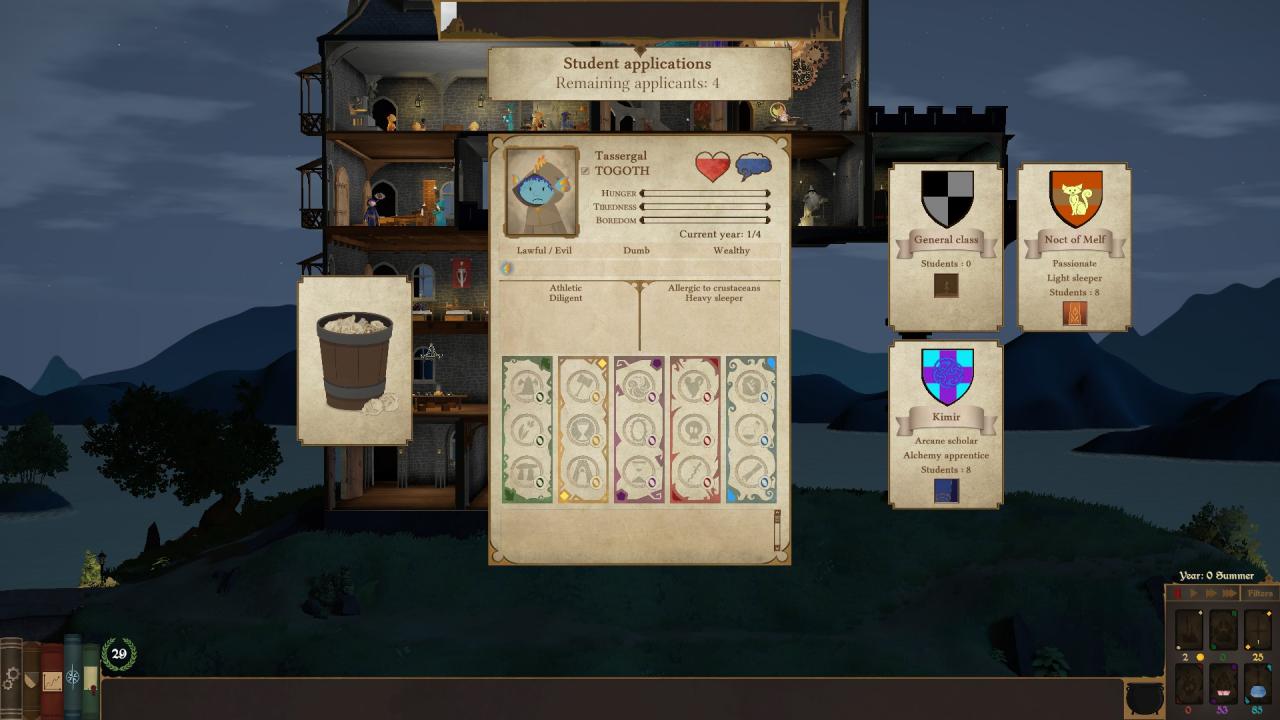 In the beginning, you need warm bodies filling up every available room slot. The castle will only have a few beds and a single refectory, but since some students will eat/sleep while others are in class you need far less than one bed per student to keep most of them in the school. For large maps like the desert where you can continue to plop down rooms with little concern for space, going with a “more is more” approach will win the game easily. Students that can’t find a class will go tend to their needs even if their need bars are quite small, so they will be ready to go the distance when a slot does open up. At normal or lower difficulty, the efficiency loss from taking as many students as possible isn’t that big of a deal, so long as you sort them into houses with no more than one forbidden magic type so they can go build some other skills if their high-priority classes are all full.
In the beginning, you need warm bodies filling up every available room slot. The castle will only have a few beds and a single refectory, but since some students will eat/sleep while others are in class you need far less than one bed per student to keep most of them in the school. For large maps like the desert where you can continue to plop down rooms with little concern for space, going with a “more is more” approach will win the game easily. Students that can’t find a class will go tend to their needs even if their need bars are quite small, so they will be ready to go the distance when a slot does open up. At normal or lower difficulty, the efficiency loss from taking as many students as possible isn’t that big of a deal, so long as you sort them into houses with no more than one forbidden magic type so they can go build some other skills if their high-priority classes are all full.
Houses break up the student body. Rather than keeping them always equal in size, put more students where they have more to do. A house that does three types of magic has more classroom space than a house that does two.
Later in the game when you have enough prestige to get five or so applicants each season, go back into the Headmaster’s office to pre-filter applicants. That reduces the number of applicants, but increases their quality. You may need to do this earlier to counteract certain curses, and which filter you pick can be complimented by the items you have in the school. Diagrams on the walls can make students smarter, repentant beds and inspiring teachers can remove flaws, but it is always better to start off on the right foot than to take on a project.
Feel free to dump that Dumb student with unfortunate negative traits instead of sorting them after the first year, especially if they are going to be around for a long time. They will just end up in a no or negative prestige future and will have taken up a room slot in the meantime. Students come for a certain number of years, as stated on their application, and you can’t expel them for being a nuisance, so after the first year you really shouldn’t accept students who are set up to fail. When the school is small in that first year the travel times are so short and there are enough open slots that a dumb student can still get enough class time to end up giving you some mana when they graduate, and putting them in an Athletic house with a focus bonus can help that out further, but near the end game with a large crowded school they will end up dead or with a -1 reputation future no matter how many buffs you have.
Of course, a Dumb student with four positive traits or no negative ones might be worth it anyway.
Setting up the Houses
- You can set up the first two houses with opposing priorities: A Shadow house full of people allergic to crustations forbidden from alchemy and an Alchemist house full of claustrophobics forbidden from Shadow magic, for example, so that the Shadow house members are never taking up slots in the Alchemy classes and vice versa. The other magic types are allowed for when Shadow and Alchemy rooms are full, but students will go out of their way to get to a class from their focus.
- I once made five houses in a later-game map, each specializing in a different magic type and forbidden from a magic type, but in a pentagram system where every possible combination was available. This can be done with as few as three houses and really gets a wide range of futures for your students. If you have some classrooms and want to use one of your early-game Castle Deck draws to get the third house you can set this up from the start. This is an alternate strategy for the Lake map where you can start with four houses. Don’t use the General class as a third house for very long or at all if you can help it.
- Alternately, you can have one a jack of all trades house (with that perk and something like Athletic, Comic, or Worker) for Dumb or otherwise sub-optimal students to keep classes full outside of your main quest house and go full elitist with only selecting the best for your Ambitious quest house.
Color-coding and naming makes sorting students quick and easy, even if you have to re-do your houses after the quest set-up phase. You can also draw a new house from the castle deck after the three star quests have kicked off and resort the entire population if you want. That isn’t necessary, really, I’m just saying that you can if you want.
I tend to name the houses based on an aversion, like the Green-robed House of “Goth Kids” (Goths have a -50% light magic debuff) that specialize in and prioritize nature magic and are forbidden from any Light magic classroom. You can change class priority, robe color, and the house name at any time, but not the house crest or traits. So, it is extremely easy to re-tool your houses after you get that first quest. Of course, this is harder if you have set up a house with two specialty buffs since that locks-in what the house will be focused on, so try to just pick one specialty buff if you haven’t gotten your quests yet. Specialty buffs do stack, so putting a Child of Nature student in a house with that trait gives them Child of Nature x2 – a 50% learning buff!
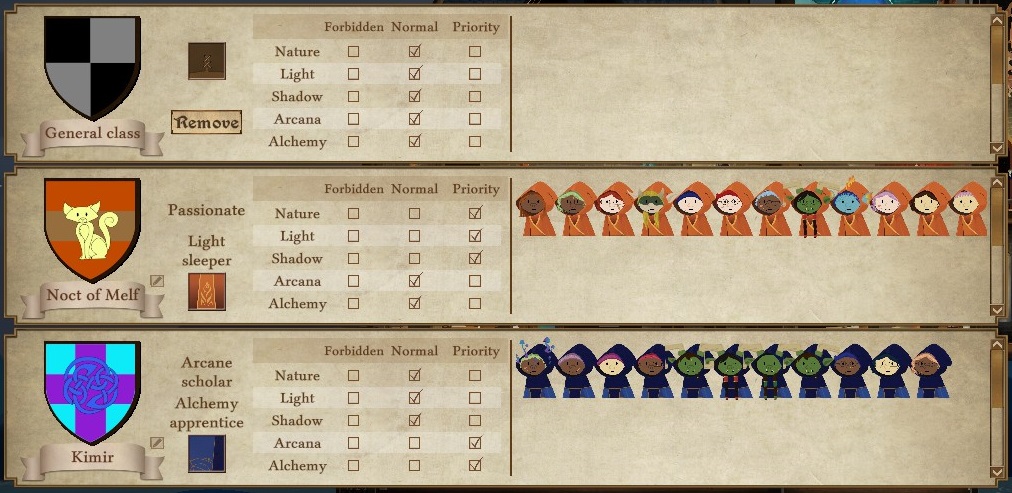 This is great if I need both Alchemy and Arcane magic specialties for a quest, but it is still early game and I don’t know that yet, so this could make getting my quest profession more difficult than it has to be if I need only Arcane or Alchemy focus. (Or worse, none of the three options I have to chose from use Arcane or Alchemy at all!) That second trait could have been a buff like Gourmet, Athletic, or Light Sleeper to get them back into class faster after a break to tend their needs. Also, having no forbidden magic and three priorities on the orange house means that if the Kimir classes are full or not in session they will fill up places in use by the other house’s priority. As the old saying goes: if everything is a priority then nothing is, so if I really want to keep the Orange robes out of the Alchemy and Arcane classes I should just forbid one or both of them.
This is great if I need both Alchemy and Arcane magic specialties for a quest, but it is still early game and I don’t know that yet, so this could make getting my quest profession more difficult than it has to be if I need only Arcane or Alchemy focus. (Or worse, none of the three options I have to chose from use Arcane or Alchemy at all!) That second trait could have been a buff like Gourmet, Athletic, or Light Sleeper to get them back into class faster after a break to tend their needs. Also, having no forbidden magic and three priorities on the orange house means that if the Kimir classes are full or not in session they will fill up places in use by the other house’s priority. As the old saying goes: if everything is a priority then nothing is, so if I really want to keep the Orange robes out of the Alchemy and Arcane classes I should just forbid one or both of them.
Steadfast is great since psychologist rooms have only one bed and you simply will never have enough of the smaller dorms that grant sanity restoration late game. Ambitious or Diligent are great for a quest house and comical is good for a Jack of All Trades house to keep the whole school from getting bored. Have fun with this and do a bit of roleplay with some fun house crests and names, there really are very few bad options for your houses on lower difficulty levels.
A house without a specialty isn’t terrible, but it won’t be as good for getting quests done as one with a specialty. That said, no buff is a bad buff except for no buff at all. So just don’t use the general class ‘house’ for long or for many students. The lack of traits makes it very inefficient. It is a good bucket to have to re-sort students (which might need to happen after you choose the round’s quests) or as a place to put students temporarily when you get a large amount at once and want to go back and even out the numbers using students that could go either way once you get all the students with obvious aversions and specialties sorted out, so it does come in handy. I have left some students in there for a season or so to see if they pick up a specialty when I have the Spellbook decor item that grants random specialties. Also, the achievement for having five houses won’t pop if you remove the general class – I think the game checks for six options during a sorting. So that Remove button really isn’t worth pressing.
You will want to make one house your ‘quest goal’ house. For Healers you need to train Herbalism (nature) and Sacred (light) so for that quest a house that focuses on, or even can only study Light and Nature will get that quest completed. For harder profession quests it might even be best to intentionally restrict the range of class types available as well as forbidding that house from learning other types of magic, skipping over that Assassination card every time to stack demonology cards instead so that students learning Shadow magic don’t ‘waste time’ learning assassination.
Thanks to Sofia Dragon for his great guide, all credit to his effort. you can also read the original guide from Steam Community. enjoy the game.
Related Posts:
- Spellcaster University: Advanced Guide to Help Make Decisions
- Bonus Cards: Bonus Cards Guide (Challenge Rewards)

